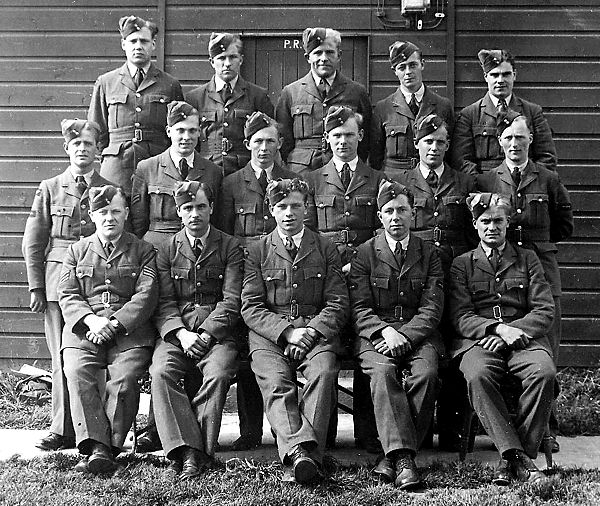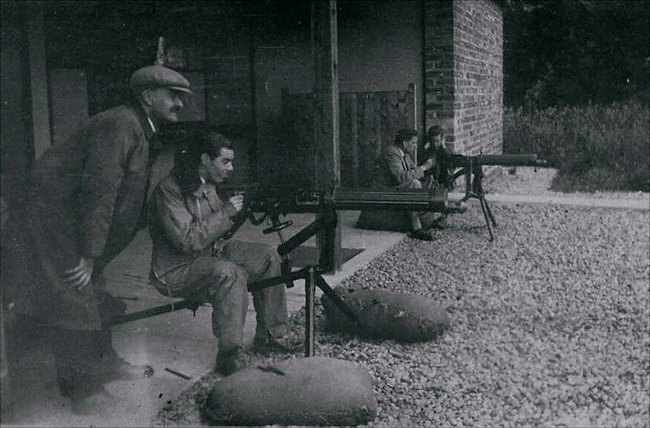|
Cyril Moore

No.8 Air Gunnery Squadron RAF Evanton,
Scotland
28th July 1941 to 23rd August 1941 Cyril had joined the RAF at 18. Aircrew had to be nineteen before they could take part in operations. He could have stayed in the relative safety of a Barrage Balloon Squadron for the rest of the war, but he decided he wanted the promotion, extra pay, danger and the ability to shoot back at Germans. He volunteered to be an Air Gunner. Cyril had to travel to the far north of Britain to start his aircrew training at No 8 Air Gunnery Squadron based at RAF Evanton. The airfield was by the seashore of the Cormarty of Firth. It was16 miles north of Inverness, on the A 9 main road, between Dingwall and Invergordon, in Scotland. Cyril was lucky to start his training during high summer. That part of Scotland gets very cold, wet and windy during the winter.

This is a photo of Cyril during
training. He is in the middle of the top row. He doesn't yet have the RAF
moustache or his Sergeant Stripes. They all had the white band
in their cap. This indicated they were aircrew in training.
Londoners knew what the white band meant. They were being bombed
by the Germans every night. RAF Aircrew, during the early years
of the war, could always count on being given a free pint of beer in any
London pub as they were one of the few branches of the British
Military that were attacking the Germans at that time. Cyril was given more inoculations and issued with his aircrew uniform. He spent his time marching on the beach, learning Morse code and aircraft recognition when he wasn’t being taught how to the operate the Fraser Nash gun turret armed with two 0.303 inch Browning machine-guns. These lessons included how the turret lifted the guns up and down again plus how to harmonise the guns. These sessions were in turrets mounted on the ground and powered by car engines from which the trainees fired live bullets at moving targets. He was instructed how to put the most bullets in the centre of the target. He learnt about the 'bullet drop', calculating the curve of fire and learning how to aim at targets considering this curve, how to build and strip down the .303 guns, eventually assembling them blindfolded, and how to find faults on these guns.

Cyril would have been trained at RAF Evanton on land targets before he even saw an Wellington Bomber.
The next part of his training was to practice firing his weapons whilst flying.
It was essential to learn how to hit a moving target whilst actually moving. The turrets were fitted with cine cameras, which recorded the accuracy of fired shots and showed whether the gunner was aiming above or below the target. Three trainee air gunners would take turns to fire 200 to 300 rounds of ammunition; the bullets of each were painted a different colour for identification afterwards. The training aircraft and tug aircraft toeing target drogues were mostly flown by Polish pilots. At that period of the war they could not be used to fly operations over Germany because if they were shot down and taken Prisoner they would be executed as a traitor. In the eyes of the Germans, Poland was part of the Third Reich.
No.8 Gunnery School used two different aircraft types for training.
Cyril flew in both aircraft. The Botha
The Blackburn Botha was a British four-seat reconnaissance and torpedo bomber. It was built by Blackburn Aircraft as a competitor to the Bristol Beaufort, and entered service with the RAF in 1939. The Botha was used for coastal patrols carrying 100 lb Anti-submarine bombs or 250 lb GP bombs. Armament comprised one forward-firing Vickers 0.303-in machine gun and two similar Lewis guns in a dorsal turret It was underpowered and was quickly withdrawn from operations after only five months. The aircraft was also unstable in flight. There were a number of fatal crashes in 1940. The RAF Air Staff made the ill-advised decision to transfer the surviving aircraft to training units, which inevitably resulted in further casualties but luckily Cyril was not affected . Some Bothas were converted to target tugs and trailed a drogue, or fabric sleeve, at the end of a long cable and student fighter pilots or air gunners would shoot at the target from other aircraft (using painted bullets so that 'hits' could be recorded and later analysed). The chief modifications to the aircraft were a station for the drogue operator and a winch (usually air-driven) to reel in the cable prior to landing; the drogue would often be jettisoned at some location convenient for recovery prior to the aircraft's landing. It was used as trainer until 1944, despite a bad safety record.

The Blackburn Botha was a British four-seat reconnaissance and torpedo
bomber The Harrow
The Handley Page H.P.54 harrow was a high wing and fixed landing gear bomber. It had power-operated gun turrets in the nose, tail and mid-upper positions. It was armed with Four 0.303 inch machine-guns, one each in nose and dorsal turrets and two in tail turret. It could carry up to 3.000 lb of bombs. In January 1937 the first RAF Squadron received the new Harrow bomber. In December 1937 production stopped after only the 100th bomber had been built. New faster bombers with bigger payloads had been developed. The Harrow however remained in service until the late stages of World War 2. They were used in training squadrons and converted to transport aircraft. Two were used to evacuate casualties from the Arnhem operation in September 1944.

The Handley Page H.P.54 harrow was a high wing and fixed landing
gear bomber.
CYRIL'S FLYING LOG - No 8 Air Gunnery Squadron RAF Evanton
4th August 1941
08.30hrs took off in a Harrow K6966 flown by Sgt Korepta. Posted Air Gunner, Sea marker Target Practice 200 Rounds Fired, Flying time 50 minutes
7th August 1941
15.15hrs took off in a Harrow K6966 flown by Sgt Mirenczvk. Posted Air Gunner, Beam Target Practice 200 Rounds Fired, Flying time1 Hour
11th August 1941
10.50hrs took off in a Botha L6147 flown by Flight Officer Eban-Ritter. Posted Air Gunner, R/S DNCO, Flying time1 Hour
11th August 1941
15.05hrs took off in a Botha L6147 flown by Pilot Officer Addy. Posted Air Gunner, R/S 100 Rounds Fired, Flying time1 Hour 5 Minutes
11th August 1941
19.20hrs took off in a Botha L6147 flown by Pilot Officer Addy. Posted Air Gunner, R/S DNCO, Flying time1 Hour
14th August 1941
18.30hrs took off in a Harrow K6964 flown by Sgt Piwke. Posted Air Gunner, Beam Target Practice 200 Rounds Fired, Flying time1 Hour 40 Minutes
15th August 1941
10.00hrs took off in a Botha L6147 flown by Sgt Eckert. Posted Air Gunner, Crossover Target Practice 200 Rounds Fired, Flying time1 Hour
15th August 1941
12.40hrs took off in a Botha L6436 flown by Sgt Westwood. Posted Air Gunner, Crossover Target Practice 200 Rounds Fired, Flying time1 Hour 10 minutes
15th August 1941
16.00hrs took off in a Harrow K6964 flown by Flight Sgt Niemekld. Posted Air Gunner, Beam Tracer Practice 200 Rounds Fired, Flying time1 Hour 25 minutes
20th August 1941
10.00hrs took off in a Botha L6435 flown by Sgt Westwood. Posted Air Gunner, R/S 100 Rounds Fired, Flying time 1 Hour
20th August 1941
16.40hrs took off in a Botha L6411 flown by Pilot Officer Konarzewski. Posted Air Gunner, Crossover Target Practice 200 Rounds Fired, Flying time 150 minutes.
At the front of Cyril’s flying log there was a stamped certificate that read
28/07/41 to 23.08.41
This is to certify that 619449 LAC Moore CP
has qualified as Air Gunner with effect 23.08.1941
No.8 A.G.S. (Air Gunnery School) at RAF Evanton,
|

